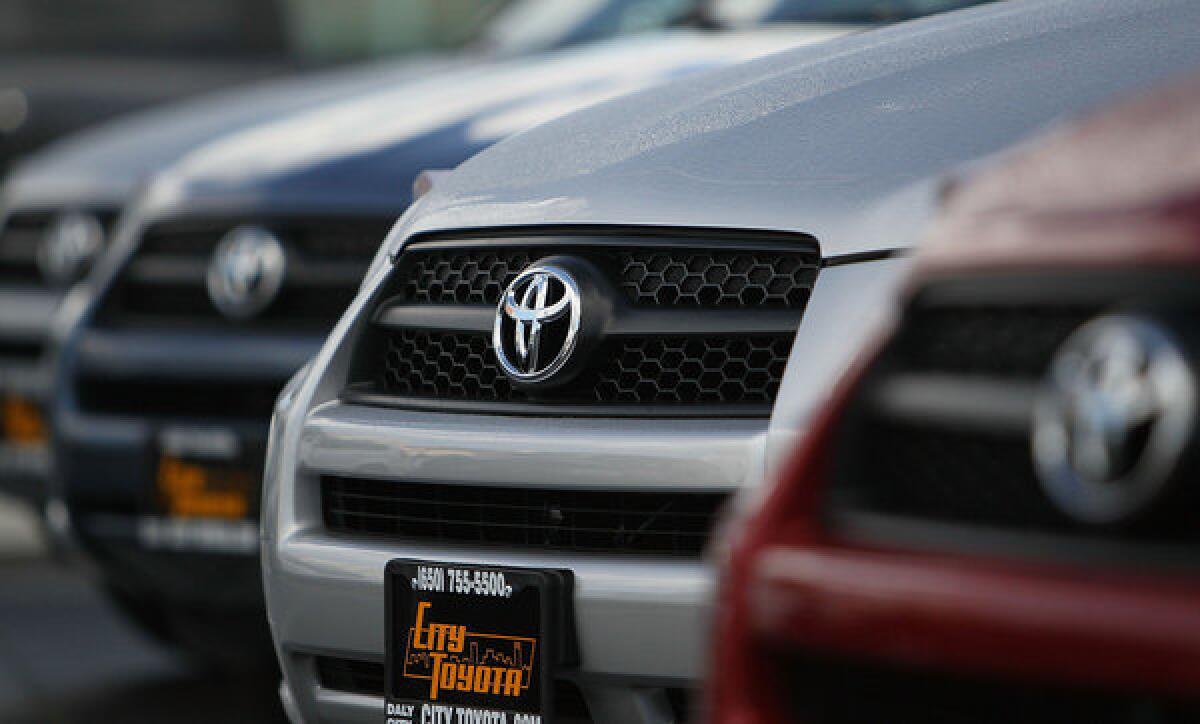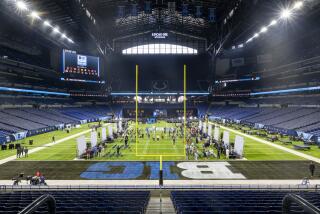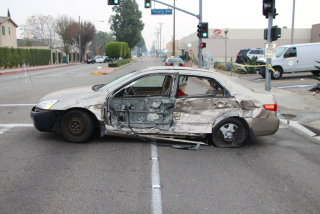Toyota to pay big to settle suits

Toyota Motor Corp., moving to put years of legal problems behind it, has agreed to pay more than $1 billion to settle dozens of lawsuits relating to sudden acceleration.
The proposed deal, filed Wednesday in federal court, would be among the largest ever paid out by an automaker. It applies to numerous suits claiming economic damages caused by safety defects in the automaker’s vehicles, but does not cover dozens of personal injury and wrongful-death suits that are still pending around the nation.
The suits were filed over the last three years by Toyota and Lexus owners who claimed that the value of their vehicles had been hurt by the potential for defects, including floor mats that could cause the vehicles to surge out of control.
ROAD TO RECALL: Read The Times’ award winning coverage
In addition, Toyota said it is close to settling suits filed by the Orange County district attorney and a coalition of state attorneys general who had accused the automaker of deceptive business practices. The costs of those agreements would be included in a $1.1-billion charge the Japanese automaker said it will take against earnings to cover the actions.
“We concluded that turning the page on this legacy legal issue through the positive steps we are taking is in the best interests of the company, our employees, our dealers and, most of all, our customers,” Christopher Reynolds, Toyota’s chief counsel in the U.S., said in a statement.
Toyota’s lengthy history of sudden acceleration was the subject of a series of Los Angeles Times articles in 2009, after a horrific crash outside San Diego that took the life of an off-duty California Highway Patrol officer and his family.
Under terms of the agreement, which has not yet been approved in court, Toyota would install brake override systems in numerous models and provide cash payments from a $250-million fund to owners whose vehicles cannot be modified to incorporate that safety measure.
In addition, the automaker plans to offer extended repair coverage on throttle systems in 16 million vehicles and offer cash payments from a separate $250-million fund to Toyota and Lexus owners who sold their vehicles or turned them in at the end of a lease in 2009 or 2010. The total value of the settlement could reach $1.4 billion, according to Steve Berman, the lead plaintiff attorney in the case.
The lawsuits, filed over the last several years, had been seeking class certification.
News of the agreement comes scarcely a week after Toyota agreed to pay a record $17.35-million fine to the National Highway Traffic Safety Administration for failing to report a potential floor mat defect in a Lexus SUV. Those come on top of almost $50 million in fines paid by Toyota for other violations related to sudden acceleration since 2010.
The massive settlement does not, however, put Toyota’s legal woes to rest. The automaker still faces numerous injury and wrongful death claims around the country, including a group of cases that have been consolidated in federal court in Santa Ana, and other cases awaiting trial in Los Angeles County.
The first of the federal cases, involving a Utah man who was killed in a Camry that slammed into a wall in 2010, is slated for trial in mid-February.
The California cases are set to begin in April, among them a suit involving a 66-year-old Upland woman who was killed after her vehicle allegedly reached 100 miles per hour and slammed into a tree.
Edgar Heiskell III, a West Virginia attorney who has a dozen pending suits against Toyota, said he is preparing to go to trial this summer in a case that involved a Flint, Mich., woman who was killed when her 2005 Camry suddenly accelerated near her home.
“We are proceeding with absolute confidence that we can get our cases heard on the merits and that we expect to prove defects in Toyota’s electronic control system,” he said.
Toyota spokesman Mike Michels said the settlement would have no bearing on the personal injury cases.
“All carmakers face these kinds of suits,” he said. “We’ll defend those as we normally would.”
The giant automaker’s sudden acceleration problems first gained widespread attention after the August 2009 crash of a Lexus ES outside San Diego.
That accident set off a string of recalls, an unprecedented decision to temporarily stop sales of all Toyota vehicles and a string of investigations, including a highly unusual apology by Toyota President Akio Toyoda before a congressional committee. Eventually Toyota recalled more than 10 million vehicles worldwide and has since spent huge sums — estimated at more than $2 billion, not including Wednesday’s proposed settlement — to repair both its automobiles and public image.
Toyota has steadfastly maintained that the only defects that could cause sudden acceleration were floor mats that could entrap accelerators as well as gas pedals that could stick in certain circumstances.
Investigations by the National Highway Traffic Safety Administration, NASA and the National Academy of Sciences found no flaws in the automaker’s electronics that could provoke the problem.
But many vehicle owners continue to claim that a software or wiring bug could be the root of the problem. In preparation for trial, attorneys have been examining the source code for Toyota’s throttle management system and consulting with engineers and electronics and software experts.
Plaintiffs’ attorneys — many of whom plan to argue that such a defect exists — believe that the potential value of the personal injury and death cases could far outstrip the $1.1-billion economic damages settlement.
“Clearly their total liability is twice what they have settled for so far and it could be much, much more,” said Raymond Johnson, a South Bay attorney handling a case involving a Camry that plunged over a cliff into the Pacific. “We just have to see how the cases go.”
Johnson said it will not be until half a dozen of the injury and death cases are tried before the full extent of the company’s liability is known. The total number of personal injury cases is difficult to estimate because some are part of a class action and others are moving ahead on their own, but Johnson estimated that there are at least dozens of the cases nationwide.
Toyota probably was able to settle the economic claims for less money by clearing them out of the way before the injury cases are heard, particularly if the company loses on the injury claims, Johnson added.
The automaker already settled what many viewed as the most damaging case against it, which was filed by the parents of the victims in the 2009 San Diego crash that killed Mark Saylor and his family. That was settled in late 2010 for $10 million.
The family still has a suit pending against the dealership that lent the Lexus to Saylor, while it was servicing his vehicle.
The amount of money that each individual vehicle owner could receive under terms of the new settlement will be determined by the legal team representing the plaintiffs, but given the millions of potential claims, it will be tiny compared with the Saylor case.
Nonetheless, legal observers were struck by the size of the proposed settlement.
“Many people thought that the economic damages cases weren’t worth a whole lot,” said Carl Tobias, a law professor specializing in torts and mass litigation at the University of Richmond. “It’s just a striking amount of money.”
More to Read
Inside the business of entertainment
The Wide Shot brings you news, analysis and insights on everything from streaming wars to production — and what it all means for the future.
You may occasionally receive promotional content from the Los Angeles Times.











